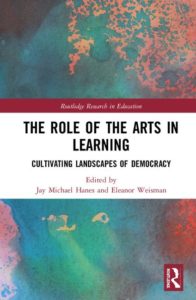New Book Exploring “The Role of the Arts in Learning” Is a Collaborative Effort
 Allegheny College Professor Eleanor Weisman thought it would be exciting to put together a book describing how the arts and sciences are fundamentally linked — and to do it with the help of her friends and colleagues.
Allegheny College Professor Eleanor Weisman thought it would be exciting to put together a book describing how the arts and sciences are fundamentally linked — and to do it with the help of her friends and colleagues.
She has done just that.
Weisman has published a collaborative new book co-edited with her husband, Jay Hanes, entitled The Role of the Arts in Learning: Cultivating Landscapes of Democracy, which might soon be used in classrooms around the country.
Weisman is an associate professor and director of dance and movement studies as well as community and justice studies at Allegheny. Hanes is an associate professor and director of the graduate and undergraduate art education programs at Edinboro University.
The book was released in June by the publisher Routledge and contains 10 chapters written by different authors, including the preface and first chapter written by Weisman and Hanes. Janyce Hyatt, a former Allegheny professor who started the Dance Studies Program and retired in 2004, wrote the Foreword to the book. The text is dedicated to Hyatt and her local work with Creating Landscapes programs in arts and education.
Many of the authors have a deep relationship with Allegheny and to Meadville, including retired faculty members Bill Bywater, who taught philosophy for more than 40 years, and David Miller in English, along with current faculty members Heather Moore and Jeff Hollerman. One author, Tibor Solymosi, graduated from Allegheny in 2003, and another, Roberta Levine, has taught first-year seminar courses and in the Gifted and Talented Enrichment Program held on campus.
“I think it’s exciting to have so many colleagues who see similar values in aesthetic education and justice,” Weisman said. “John Dewey said that the most important freedom is the freedom of intelligence to think about possibilities and imagine the world that you want and that’s what many of our colleagues have done in this process.”
This was the first book the couple edited together and the effort took about two years to complete. Weisman said it was an interesting process to find a publisher and then to manage all the different writing styles of the individual authors.
“All the authors are from a wide range of fields, so it’s a truly interdisciplinary effort,” Hanes said.
Themes addressed in this book include how arts and sciences are fundamentally linked, not separated, with the goal of providing motivation to integrate learning substance and style for students from diverse backgrounds and cultures.
Weisman said the book could be viewed as a conversation on aesthetic learning and civic engagement with marginalized voices. It is an academic anthology presenting the work of several Allegheny scholars as well as other authors working with the expressive arts and sciences in education.
“It’s about getting ideas out there to others in education. We see a totally different idea of what education could be,” Weisman said. “If we want young people to become active participants in democracy then young citizens need to have the tools of arts and science and be guided to work together. We see this book as promoting some of those ideas and strategies.”
As an educator, Weisman said it’s inspiring to think about the new book being used in the classroom.
“There are several chapters that would be very useful for our students to read,” she said. “It’s exciting to think of specific chapters being read by young people who will go on to promote democratic justice in their futures.”